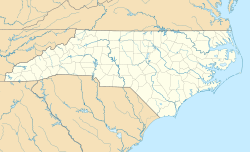Stallings-Carpenter House facts for kids
Quick facts for kids |
|
|
Stallings-Carpenter House
|
|
| Built | 1845 |
|---|---|
| Architectural style | Greek Revival |
| NRHP reference No. | 83001894 |
| Added to NRHP | March 28, 1983 |
The Stallings-Carpenter House is a historic home located near Clayton, North Carolina in Johnston County, North Carolina. It was built in 1845 by James and Elizabeth Stallings. The house is designed in the Greek Revival style, which was popular at the time. It was officially added to the National Register of Historic Places on March 28, 1983, recognizing its importance in history.
Contents
History of the Stallings-Carpenter House
Early Owners and Builders
The land where the Stallings-Carpenter House stands has a long history. In the early 1800s, a well-known lawyer and landowner named Moses Mordecai owned the property. He lived in Raleigh, North Carolina.
When Moses Mordecai passed away, he left the land to his daughter, Ellen. She was supposed to get the property when she turned 21, but only if she was married. Ellen was still unmarried at 21, so the land was sold in 1850.
The Stallings Family Farm
The property was bought by James Stallings and Elizabeth Jones, who had just gotten married. They built the house we see today and started a farm. By 1860, the Stallings family owned a large amount of land, about 1,200 acres (4.9 square kilometers).
They used their farm to raise animals and grow many different crops. These included corn, peas, beans, oats, and sweet potatoes. The town of Stallings Station, which is now called Clayton, was even named after James Stallings!
Later Owners and Preservation
In 1904, the property was sold to Ashley Horne. He was an important person in North Carolina. Ashley Horne served in the state government and helped start what is now North Carolina State University. He even tried to become the state's governor.
Ashley Horne did not live in the house himself. Instead, he rented it out and leased the rights to cut timber from the land. Over the years, the house had several different owners. Eventually, it was carefully restored to its original condition. After its restoration, it was listed on the National Register of Historic Places.
Even in 2008, the land around the house was still used for farming and growing timber. However, the large 1,200-acre property has since been divided into smaller pieces.


